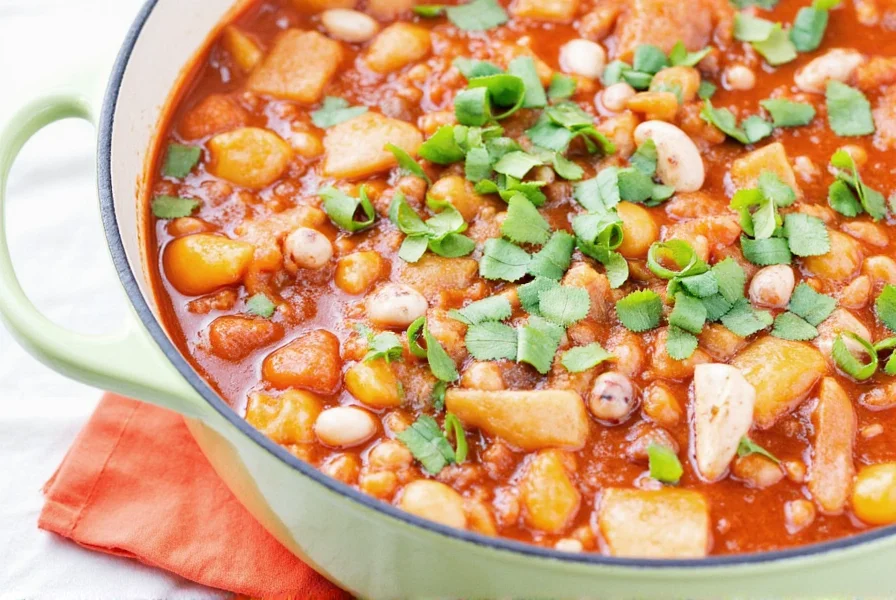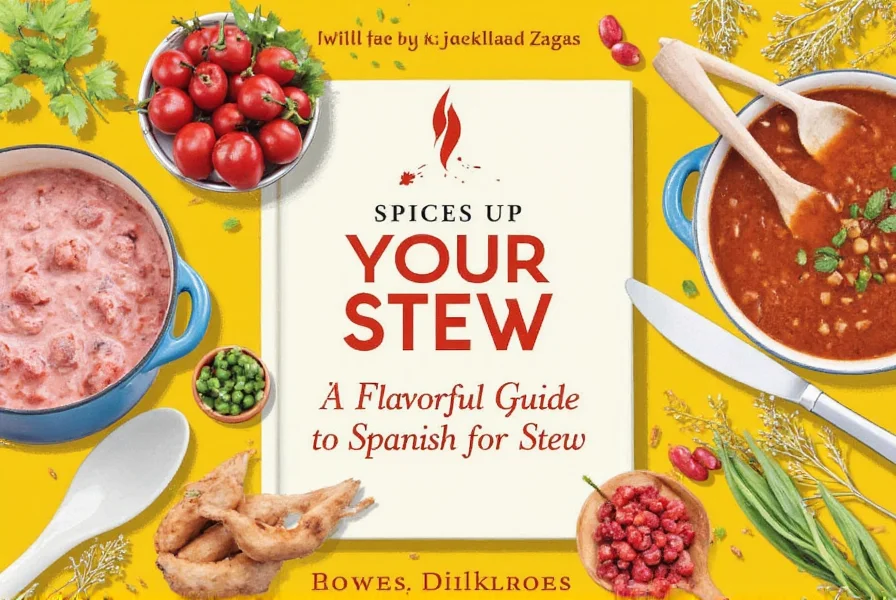Table of Contents
- Introduction
- Key Spices in Traditional Spanish Stews
- Understanding Smoked Paprika (Pimentón)
- Saffron: The Golden Spice of Spanish Cuisine
- Other Essential Spices for Spanish Stews
- Practical Tips for Using Spanish Stew Spices
- Buying Guide: Authentic Spanish Spices
- Frequently Asked Questions
- Conclusion
Introduction
Contrary to common misconceptions, there is no single spice blend called "Spanish for Stew." Authentic Spanish stews rely on a combination of traditional spices carefully selected for their regional dishes. This guide clarifies the key spices used in Spanish cuisine, their roles in traditional stews like Cocido Madrileño and Fabada Asturiana, and how to use them effectively. Whether you're a home cook or culinary professional, understanding these authentic ingredients will elevate your Spanish-inspired dishes.

Key Spices in Traditional Spanish Stews
Spanish cuisine features regional spice profiles rather than a universal "stew blend." The most critical spices include:
- Smoked Paprika (Pimentón): The backbone of Spanish stews, available in sweet (dulce), bittersweet (agridulce), and hot (picante) varieties
- Saffron: Used in premium dishes like Paella and some regional stews for its distinctive color and aroma
- Garlic: Fundamental to Spanish flavor profiles, often used fresh or powdered
- Oregano: Mediterranean variety (not Mexican) with earthy notes
- Bay Leaves: Essential for slow-cooked stews
Understanding Smoked Paprika (Pimentón)
Smoked paprika is the cornerstone of Spanish stews. Unlike regular paprika, it's made by smoking red peppers over oak fires before grinding. This process creates three distinct varieties:
| Variety | Description | Best Uses |
|---|---|---|
| Sweet (Dulce) | Mild, sweet, and smoky with no heat | Classic Cocido Madrileño, chorizo, and general stew seasoning |
| Bittersweet (Agridulce) | Balanced smokiness with slight bitterness | Bean stews like Fabada Asturiana and meat-based dishes |
| Hot (Picante) | Spicy with pronounced smokiness | Regional dishes like Patatas Bravas or spicy stews |
Authentic Spanish smoked paprika carries a DOP (Protected Designation of Origin) status for regions like La Vera. Look for "Pimentón de la Vera" on labels for guaranteed quality.
Saffron: The Golden Spice of Spanish Cuisine
While not used in every Spanish stew, saffron is essential for certain regional dishes. The world's most expensive spice comes from crocus flowers and requires careful handling:
- Quality indicators: Deep red threads with orange tips, strong floral aroma, and no yellow stamens
- Usage tips: Steep threads in warm liquid before adding to dishes to release maximum flavor
- Traditional applications: Paella, Arroz a la Cubana, and some seafood stews
Authentic Spanish saffron comes from La Mancha region. Avoid products labeled "saffron powder" as they're often adulterated.
Other Essential Spices for Spanish Stews
While paprika and saffron take center stage, these supporting spices complete authentic Spanish flavors:
| Spice | Role in Spanish Cuisine | Culinary Notes |
|---|---|---|
| Garlic | Base flavor in nearly all Spanish dishes | Use fresh cloves for stews; garlic powder works for dry rubs |
| Mediterranean Oregano | Earthy, slightly bitter notes | Distinct from Mexican oregano; use dried for stews |
| Bay Leaves | Subtle background flavor | Always remove before serving; 1-2 leaves per pot |
| Black Pepper | Enhances other spices | Freshly ground preferred; use sparingly to avoid overpowering |
| Thyme | Common in Catalan and Andalusian stews | Dried thyme works best for slow-cooked dishes |
Practical Tips for Using Spanish Stew Spices
- Toast whole spices before grinding for maximum aroma
- Layer flavors by adding spices at different cooking stages (e.g., paprika early for depth, saffron late for color)
- Use authentic ingredients - Spanish smoked paprika differs significantly from regular paprika
- Balance heat: Start with sweet paprika, then add hot varieties sparingly
- Respect regional traditions: Fabada uses bittersweet paprika, while Cocido typically uses sweet

Buying Guide: Authentic Spanish Spices
When purchasing Spanish spices, prioritize quality indicators:
- Smoked Paprika: Look for "Pimentón de la Vera" DOP certification. Recommended brands: La Chinata, El Rey, and La Española
- Saffron: Choose threads (not powder) from La Mancha region. Trusted brands: Azafranes La Mancha, Saffron by Saffron House
- Garlic: Prefer fresh Spanish garlic bulbs (from Las Pedroñeras) over powdered versions
- Oregano: Look for "Orégano de la Mancha" or Mediterranean varieties
Avoid products with artificial additives, fillers, or vague labeling like "Spanish-style" without regional origin details.
Frequently Asked Questions
Is there a specific "Spanish for Stew" spice blend?
No. Authentic Spanish cuisine doesn't have a single "stew blend." Instead, regional dishes use specific spice combinations. For example, Cocido Madrileño relies on sweet smoked paprika and bay leaves, while Fabada Asturiana uses bittersweet paprika and white beans. Always match spices to the specific dish you're preparing.
What's the difference between regular paprika and Spanish smoked paprika?
Regular paprika is made from dried sweet peppers without smoking. Spanish smoked paprika (pimentón) undergoes a 10-15 day oak smoking process before grinding, creating its signature smoky flavor. The smoking process also affects color intensity and heat level, with three distinct varieties (sweet, bittersweet, hot). This is why authentic Spanish dishes require pimentón, not regular paprika.
Can I substitute regular paprika for smoked paprika in Spanish stews?
Not recommended. Smoked paprika's unique flavor profile is irreplaceable in traditional Spanish dishes. Substituting regular paprika will result in a flat, non-authentic taste. If you can't find smoked paprika, look for "pimentón de la Vera" - it's the only authentic option for Spanish cuisine.
Which Spanish spices are essential for beginners?
Start with three core ingredients: sweet smoked paprika (for most stews), saffron (for paella and seafood dishes), and fresh garlic. These form the foundation of Spanish cuisine. Once comfortable, add bittersweet paprika for bean stews and Mediterranean oregano for regional variations.
How should I store Spanish spices for maximum freshness?
Store all spices in airtight containers away from light and heat. Smoked paprika and saffron are particularly sensitive - keep them in dark glass jars in your pantry. Properly stored, smoked paprika lasts 6-12 months, while saffron threads retain quality for 2-3 years. Never refrigerate spices as moisture causes clumping.
What's the most common mistake when using Spanish spices?
Using regular paprika instead of smoked paprika (pimentón). Many recipes mistakenly call for "paprika" when they actually require the distinct smoked variety. Always check if the recipe specifies "smoked paprika" or "pimentón" - if not, assume it's the smoked variety for authentic Spanish dishes.
Conclusion
Authentic Spanish stews rely on carefully selected regional spices rather than a single "blend." Smoked paprika (pimentón) forms the foundation, with saffron, garlic, and Mediterranean herbs completing the flavor profile. By understanding these ingredients' roles and sourcing authentic products, you can create truly traditional Spanish dishes that capture the essence of Spain's culinary heritage. Remember: quality matters more than quantity - a few authentic spices will always outperform generic blends.











 浙公网安备
33010002000092号
浙公网安备
33010002000092号 浙B2-20120091-4
浙B2-20120091-4